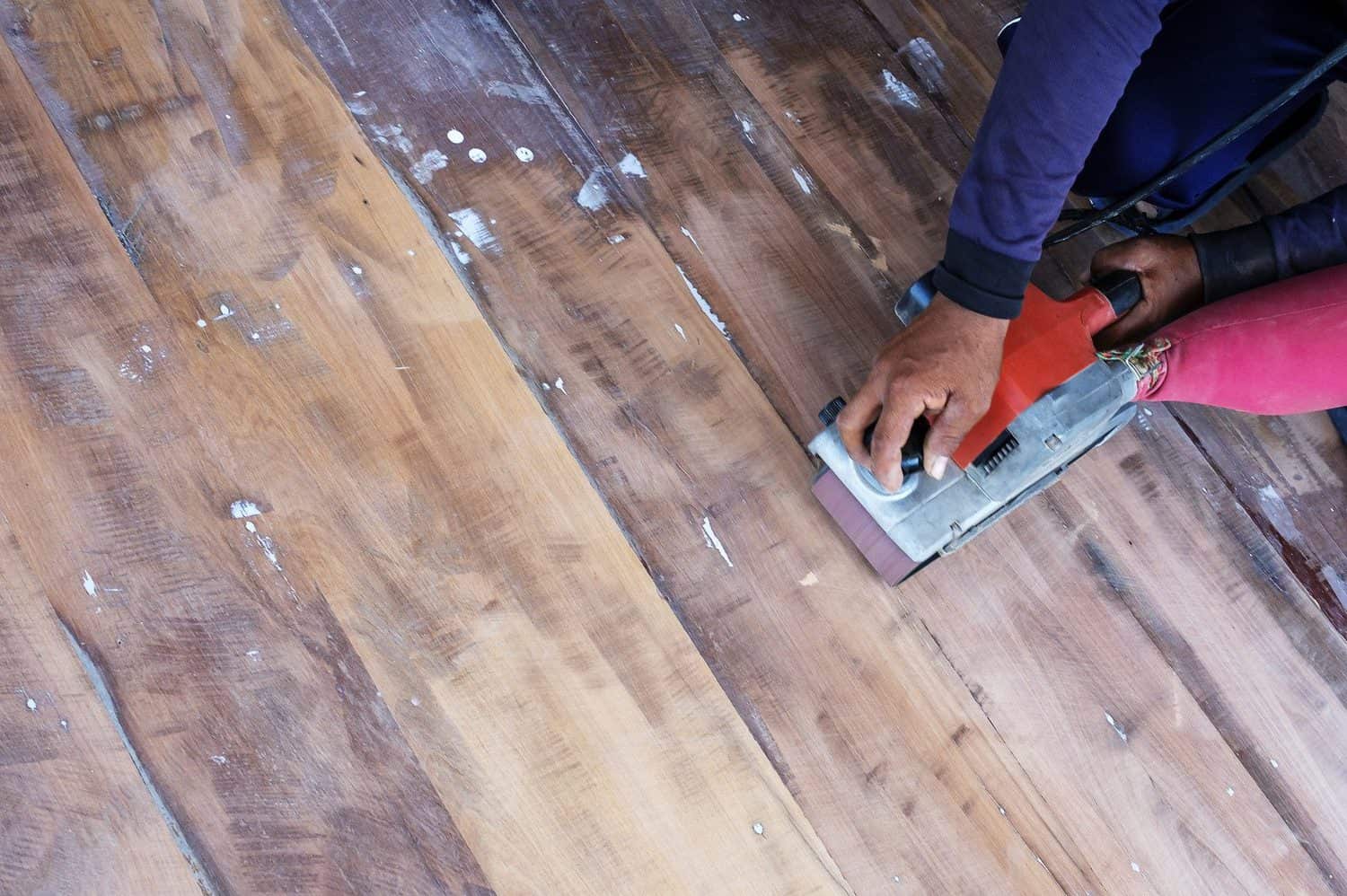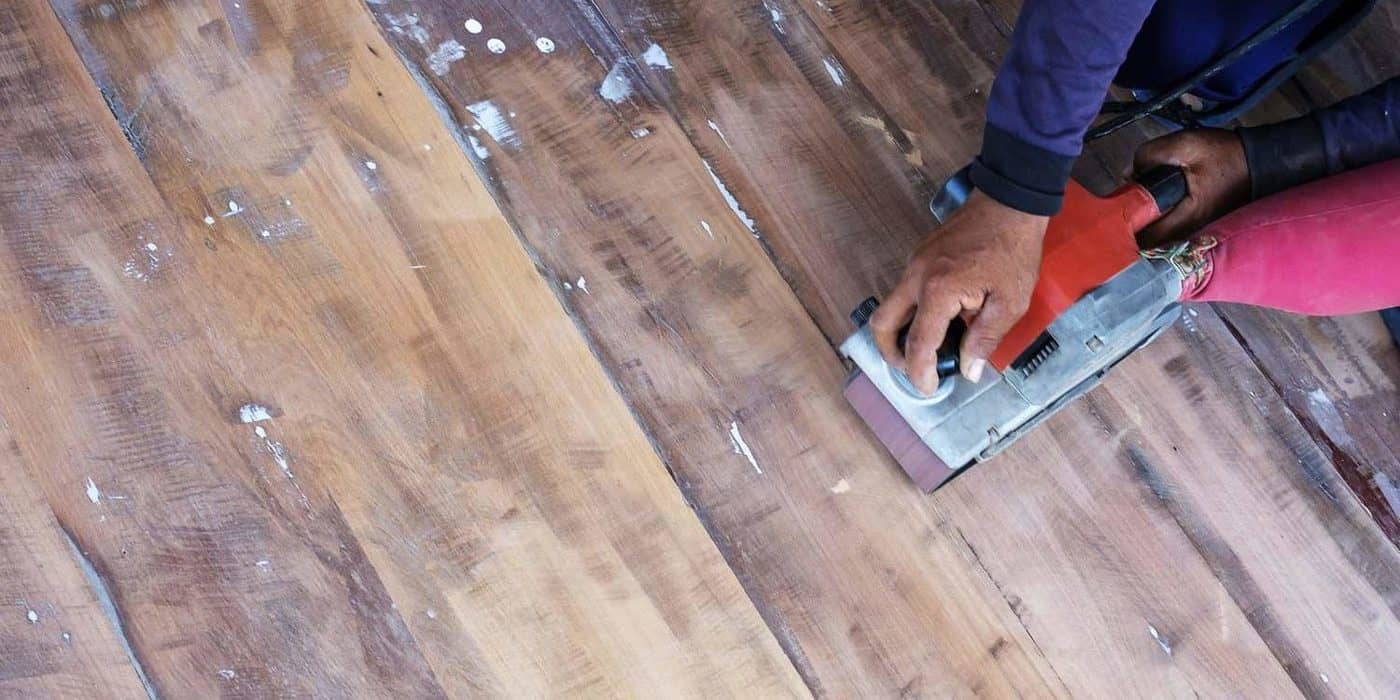
Whether you need to remove a stain or refresh the space, bleaching hardwood can get you results.
Bleaching hardwood floors is a chemical process to lighten the color of the wood. Sometimes your hardwood floors become discolored with age or accidental stains. Occasionally, homeowners choose to lighten their floors in preparation for special finishes, such as antiquing or pickling.
Learn how to bleach your hardwood floors, including what type of bleach to use, to get the job done correctly.
Types of wood bleach
There are three types of bleach you can use on wood: chlorine bleach, “two-part” (peroxide) bleaches and oxalic acid. Not all bleaches are interchangeable. The best bleach for your floor depends on the source of color you seek to remove. The challenge, then, is to know what made the stain and which bleach is appropriate.
- Chlorine bleach: Just like in the laundry room, chlorine bleach will remove dyes and many organic stains such as tea, blood, berry-based juices and other foods. Using household bleach is the mildest form and may take several treatments to prove effective. For a stronger chlorine-based bleach treatment, choose swimming pool chlorine (calcium hypochlorite). Purchase swimming pool chlorine at a local superstore or swimming pool supply.
- Two-part bleaches: While chlorine bleach combats many inks, dyes and organic stains, it doesn’t significantly alter the wood color. A two-part bleach is the only choice for altering wood color. Some stains that do not respond to either oxalic or chlorine bleaches will disappear when treated with two-part bleaches. Look for this type of bleach at your local hardware or home improvement store.
- Oxalic acid: Nothing combats iron and rust stains like oxalic acid. It also removes water stains (which arise due to the iron content of water) and some black inks that are iron-based, although it’s not effective against carbon-based India ink. Even pet urine stains may respond to oxalic acid. You can purchase oxalic acid in a crystal form at pharmacies and hardware or home improvement stores, as well as other sources. Use pure oxalic acid for best results.
Occasionally, you may find reference to other bleaching solutions. Chlorinated lime bleaching, for instance, is often used for walnut in particular. Permanganate of potash, on the other hand, creates a bleach that leaves a residual purple tint. Both of these chemicals are readily available online and from local stores or pharmacies. Simply dissolve the chemicals in water, creating a strong solution. Paint on, wait for the solution to work, and neutralize as you would with any other bleach.
Bleach application and safety guidelines
Before applying any bleaching agent to your hardwood floors, consider the size of the area you wish to bleach and the condition of your floor, along with the nature of the bleach itself. Any bleach will deteriorate the wood slightly. The chemically weakened wood fibers are more susceptible to wear and tear from foot traffic. For this reason, many professionals discourage bleaching wood floors.
Bleaching stains isn’t as destructive as bleaching the entire floor to remove wood color, since it involves a limited area. It’s also much easier: You must remove the finish — either with a stripper or by sanding — before applying wood bleach.
When spot-bleaching your hardwood floor, you may be able to remove the finish only in the affected area, bleach and neutralize the treatment, then refinish the surface and blend it in with the surrounding floor — provided you have matching finish products.
For extensive stains, or if you’re unable to match the finish, you may choose to strip the entire floor before bleaching.
Here are some other application and safety tips to consider:
- Some stains and marks lend character to the floor. Think before using bleach as a stain remover: Is the stain bad enough that you want to subject your floor to bleach?
- Is there an out-of-the-way area where you can test the bleach’s effect on your hardwood floor? If you wish to bleach your entire floor, try it first on a spare board.
- Consider sanding to remove the existing finish. Sanding the wood has one particular advantage: It allows you to possibly sand away the stain, if it isn’t very deep, instead of applying harsh bleaching agents.
- Redwood, cedar, cherry and rosewood don’t bleach well. Some of the more exotic woods, such as mahogany, are prized for their color and aren’t considered suitable for bleaching. Avoid bleaching white oak as well. It has a tendency to discolor when bleached and may leave you dissatisfied with the appearance.
- Use the least amount of bleach possible, whether bleaching the wood or treating a stain. Some woods react poorly to over-bleaching. Walnut, for instance, will attain a green haze.
- When using a commercial bleaching product, follow the product manufacturer’s instructions carefully for safety and best results.
- Always wear safety glasses and rubber gloves when working with bleaching products. Any bleach is extremely caustic and may burn your skin, blind your eyes or damage your lungs. Use with extreme caution.
- Ventilate your workspace. Keep windows open, fans running, and pets and children away from the area.
- Wear a dust mask or respirator when sanding bleached wood or working with dry bleach chemicals.
- Pour a bit of the neutralizer (see information below) suited to your bleach in a small bowl or bucket. Place it near your work area and use immediately if you notice you have spilled or splattered bleach on yourself.
- Don’t cross-contaminate brushes, rags and other applicators. Wash immediately or dispose of properly after use.
- Wash your hands and arms after working with bleach and before doing anything else.
How to strip, bleach and neutralize your floor
If you’re lucky, you know exactly what made the stain and which bleach to use as a result. In some cases, finding the right bleach is more a process of elimination.
Start with chlorine bleach and progress to oxalic acid if necessary. If your wood is finished, you’ll have to strip your wood and then neutralize the bleach.
Here’s how to strip, bleach and neutralize your hardwood floor:
- Remove the existing finish, using the appropriate product: Lacquer thinner dissolves lacquer finishes (commonly used on modern wood floors), while denatured alcohol removes shellac. A commercial paint-and-varnish remover will work on most other finishes. Either brush on the product or lay a thick layer of paper towels or rags across the area and pour on enough product to saturate the cloths. Wait for the finish to dissolve the wipe away as it softens. Use a plastic spatula or wood scraper as necessary, taking care to avoid gouging the wood.
- Follow with sandpaper to lightly smooth the surface and remove any remaining finish. Start with 80-grit sandpaper and end with 120-grit.
- Mix a solution of washing soda — sometimes called sal soda — with hot water in a small bucket. Follow the ratio recommended in the product instructions (purchase washing soda in the laundry aisle of your big box store). Wash over the stripped wood with the solution to remove stripping chemicals and other contaminants. Air-dry before bleaching.
- Prepare the bleach of your choice. For chlorine bleach, use either a full-strength or half-and-half solution of laundry bleach mixed with hot water (or swimming pool bleach dissolved in hot water), until the solution is completely saturated. To mix oxalic acid, start with about 8 ounces of oxalic acid crystals dissolved in 2 quarts of hot water. Continue adding until the solution is saturated and won’t accept more crystals. For two-part bleaches, follow the product instructions, mixing parts A and B as necessary.
- Use a synthetic-bristled brush to apply the bleach. Avoid natural bristles, which may dissolve, or metal materials, which will create a chemical reaction with the bleach. Spread a consistent layer of bleach across the wood. Place a paper towel over top to keep it from drying too fast in warm conditions. Wait 20 to 30 minutes, or as instructed by the two-part bleach product, before testing the wood color. When the color matches your expectations, blot up any remaining bleach.
- Flush the area with distilled water to rinse away excess bleach. Using distilled water prevents water stains caused by the iron in regular water. Prevent the rinse water from invading the surrounding finished floor surface.
- Neutralize the bleached area to stop the bleaching action. For chlorine or two-part bleaches, use a blend of half hot water and half white vinegar. Oxalic acid requires a mixture of 2 tablespoons of baking soda dissolved per quart of hot water.
- Allow the wood to air-dry at least 24 hours. Follow with another sanding, using 120-grit sandpaper to smooth the wood fibers, which are rough after bleaching. Alternatively, coat the wood with a light coat of lacquer and sand through that instead. The lacquer stiffens the wood and helps the sanding.
- Refinish the bleached spot — or the entire floor — as desired.
In some cases, the stain or color may not lift. Feel free to try successive bleach treatments, but at some point you may need to settle for what you achieve. Consider alternatives to bleaching when the results are less than what you prefer.
Related:
This post first appeared on Zillow.com. To see the original, click here.
